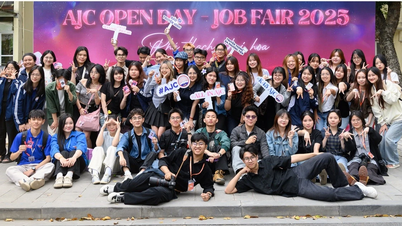These challenges not only raise questions about the future of journalism, but also open up new opportunities for innovation and creativity.
Challenges from social media fluctuations
Social media, once a magical world for sharing information, is undergoing significant upheaval. Facebook’s withdrawal from the news business, the constant changes at X (formerly Twitter) since it was acquired by billionaire Elon Musk, and the political issues that plague TikTok are all challenges facing the journalism industry.

World press can turn challenges into opportunities in the coming time. Illustration photo: Reuters
Twitter is constantly changing its interface, algorithm, and how it displays content, creating an unstable environment for users and the press. TikTok, while known for its creative and short-form content, is facing political issues related to power and security.
Facebook’s exit could be an opportunity for smaller platforms to emerge and bring diversity to news sources. The platform changes could encourage a focus on content quality rather than algorithmic selection.
Journalism needs to diversify its news sources and not rely on a single platform to avoid risks. The opportunity for journalism to innovate lies in how it interacts and communicates with readers, despite the volatility of social media. Volatility can be the driving force for journalism to face challenges, thereby taking advantage of new opportunities from diversity and creativity.
Journalism can take advantage of these changes to create a diverse, creative and accurate information environment that reflects the needs of its readers. It is important that journalism is flexible, creative and constantly innovating to overcome challenges and seize opportunities in this turbulent period.
Challenges from artificial intelligence (AI)
AI can help enhance content production, reduce time and costs, allowing news organizations to focus more on strategic and creative content. AI automation can help news websites and apps update continuously and quickly.
Additionally, AI can be used to customize content based on readers’ reading history, interests, and behavior, creating personalized experiences. This technology can help news organizations analyze content performance, evaluate reader engagement, and optimize content strategies.
AI systems can be used to detect fake news and fact-check information, helping to improve the credibility of journalism. Additionally, AI can assist in the creation of artistic content, from generating headlines to creating creative images and videos .
However, large language models can generate very convincing fake news, increasing the risk of spreading inaccurate information. Automation can lead to the production of uniform and unoriginal content, reducing quality and adding value to readers.
The development of artificial intelligence and large language models brings opportunities and challenges to the journalism industry, and also raises the need for intelligent and creative management to face challenges and effectively take advantage of opportunities.

Journalists need to show their role in the upcoming volatile media world. Illustration photo: OMH
Opportunity to build and develop online communities
Online communities are not only a means of communication but also an important resource for the success of media and journalism organizations.
It provides a platform for readers or viewers to provide immediate feedback, helping the media organization gain a better understanding of the opinions of its readers and customers. Online communities help build a friendly relationship between the organization and its community, creating closeness and trust.
Online communities are often a source of new ideas and encourage creativity, especially when there is active participation from the following community. They are also a place to share content and information, helping news organizations expand their reach.
Communities provide a diverse source of inspiration and opinions, helping media organizations create rich content that reflects the diverse needs of their audiences. Active community engagement can create a sense of commitment, making readers and viewers feel like they belong to a special community.
Online communities are not only a communication tool but also an important resource that helps media organizations build, develop and maintain positive relationships with their audiences.
Podcasts have become a powerful and promising media format that offers many benefits for community building. Audio can convey emotion and humanity more effectively than text or images. Podcasts help create a personal connection between the sharer and the listener.
Podcasts are available to listen anytime, anywhere, creating flexibility and convenience for listeners. This helps attract a wide and diverse audience from all over the world. Listeners often feel like they “know” the host through the voice and style of the podcast. This creates a strong reader-host relationship and can foster loyalty.
Podcasts can often attract long-term attention from listeners. Listeners can put them on playlists and listen to them later, creating a long-term performance. It is not only a media tool but also a powerful means of building and maintaining community through interaction, human communication and diversity in content.
The time has come for innovation
In the era of social media change, the journalism industry is facing significant challenges. However, this change also opens up new opportunities for innovation and creativity. Journalists can take advantage of these changes to create a diverse, creative information environment that accurately reflects the needs of readers.
The challenges posed by the upheaval of social media and artificial intelligence are not barriers but actually enablers for innovative solutions. By understanding the enduring nature of human needs, promoting community-centered approaches, and exploring new ways to communicate with audiences, journalists can navigate this dynamic environment and contribute to a vibrant future for the media industry.
The constant transformation of journalism creates a landscape for innovation. With the right mindset, the future offers endless opportunities for those willing to adapt and explore. It is important for journalism to be flexible, creative and constantly innovate to overcome challenges and take advantage of opportunities in these turbulent times.
Minh Anh
Source


![[Photo] Solemn opening of the 8th Congress of the Central Public Security Party Committee, term 2025-2030](https://vphoto.vietnam.vn/thumb/1200x675/vietnam/resource/IMAGE/2025/10/4/f3b00fb779f44979809441a4dac5c7df)


![[Photo] General Secretary To Lam attends the 8th Congress of the Central Public Security Party Committee](https://vphoto.vietnam.vn/thumb/1200x675/vietnam/resource/IMAGE/2025/10/4/79fadf490f674dc483794f2d955f6045)

![[Photo] Bustling Mid-Autumn Festival at the Museum of Ethnology](https://vphoto.vietnam.vn/thumb/1200x675/vietnam/resource/IMAGE/2025/10/4/da8d5927734d4ca58e3eced14bc435a3)
























































![[VIDEO] Summary of Petrovietnam's 50th Anniversary Ceremony](https://vphoto.vietnam.vn/thumb/402x226/vietnam/resource/IMAGE/2025/10/4/abe133bdb8114793a16d4fe3e5bd0f12)

![[VIDEO] GENERAL SECRETARY TO LAM AWARDS PETROVIETNAM 8 GOLDEN WORDS: "PIONEER - EXCELLENT - SUSTAINABLE - GLOBAL"](https://vphoto.vietnam.vn/thumb/402x226/vietnam/resource/IMAGE/2025/7/23/c2fdb48863e846cfa9fb8e6ea9cf44e7)



































Comment (0)